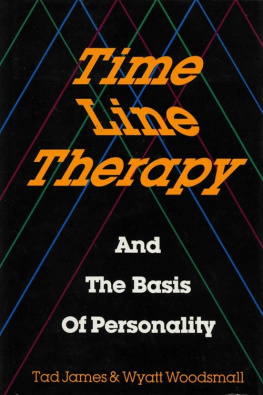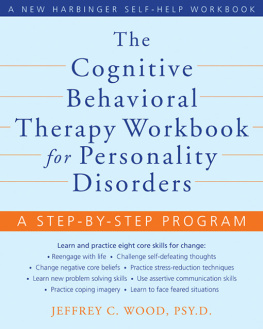James Tad - Time line therapy and the basis of personality
Here you can read online James Tad - Time line therapy and the basis of personality full text of the book (entire story) in english for free. Download pdf and epub, get meaning, cover and reviews about this ebook. City: Cupertino, Calif, year: 1988, publisher: Meta Publications, genre: Religion. Description of the work, (preface) as well as reviews are available. Best literature library LitArk.com created for fans of good reading and offers a wide selection of genres:
Romance novel
Science fiction
Adventure
Detective
Science
History
Home and family
Prose
Art
Politics
Computer
Non-fiction
Religion
Business
Children
Humor
Choose a favorite category and find really read worthwhile books. Enjoy immersion in the world of imagination, feel the emotions of the characters or learn something new for yourself, make an fascinating discovery.
- Book:Time line therapy and the basis of personality
- Author:
- Publisher:Meta Publications
- Genre:
- Year:1988
- City:Cupertino, Calif
- Rating:5 / 5
- Favourites:Add to favourites
- Your mark:
- 100
- 1
- 2
- 3
- 4
- 5
Time line therapy and the basis of personality: summary, description and annotation
We offer to read an annotation, description, summary or preface (depends on what the author of the book "Time line therapy and the basis of personality" wrote himself). If you haven't found the necessary information about the book — write in the comments, we will try to find it.
James Tad: author's other books
Who wrote Time line therapy and the basis of personality? Find out the surname, the name of the author of the book and a list of all author's works by series.
Time line therapy and the basis of personality — read online for free the complete book (whole text) full work
Below is the text of the book, divided by pages. System saving the place of the last page read, allows you to conveniently read the book "Time line therapy and the basis of personality" online for free, without having to search again every time where you left off. Put a bookmark, and you can go to the page where you finished reading at any time.
Font size:
Interval:
Bookmark:

Time Line Therapy
And
The Basis of Personality Section I: Introduction Section II: Time Line Therapy Chapter 1: Introduction to Time Line '
Chapter 2: Through Time and In Time
The Two Types
Chapter 3: Discovering The Time Line Chapter 4: Memory Management Chapter 5: Language and Time, The Meaning of Words
Chapter 6: Your Client's Internal Representation of Time
Chapter 7: Handling Trauma Chapter 8: The Language of Time Chapter 9: Time Line Therapy
A Demonstration
Chapter 10: Programming Your Future with Time Line
Chapter 11: Time Line Therapy Outline Section III: Meta Programs Chapter 12: Introduction to Meta Programs Chapter 13: The Simple Meta Programs Chapter 14: Complex Meta Programs Chapter 15: Changing Meta Programs Section IV: Values
Chapter 16: Introduction to Values Chapter 17: The Formation of Values Chapter 18: The Evolution of Values Chapter 19: Resolving Beliefs and Values Conflicts
Chapter 20: The Hierarchy of Ideas Chapter 21: Changing Values Chapter 22: Utilizing and Changing Values Time Line Therapy and The Basis of Per-sonalityis a study of most of the important elements that make up a person's core personality. These include Time Line Therapy (Memory Storage), Meta Programs and Values.
Time Line Therapy. Utilizing discoveries by Richard Bandler, the authors have expanded and updated our knowledge of how people actually store their memories, and the effect that the system used for the storage of memories has on the personality of the individual.
The authors contend that the concept of Time Line, or the notion of time that you have stored in your mind, shapes and structures your experience of the world, and therefore shapes your personality.
Meta Programs. Meta Programs are the most basic filters that process the sensory data that we receive from the outside world. Knowing a person's Meta Programs can assist in the prediction of their behavior, and can assist in communicating to them. The authors' work in this area is well known, and is the most thorough available on the subject of Meta Programs.
Values. Values also serve as filtering mechanisms in the processing of our sensory data, and as such they are the most basic level of filters that have content in and of themselves. Values are more basic than beliefs, providing the push behind our motivation, and provide the selection criteria for our strategies.
Values are how we evaluate right and wrong, and are the basis for our evaluation of our behavior.
Tad James, M.S., Ph.D., is certified by the Society of NLP as a Master Trainer. He has a Master's Degree in Communication and Doctor of Philosophy in Erickso-nian Hypnosis. Tad James is a business consultant, and the Founder and Chair-man of the Board of The Profitability Group, Inc., a publicly traded, Hawaii based corporation, offering the latest techniques in human resource development combining Neuro-Linguistics, Neural-Physics, General Semantics and Time Line TherapyyRichard Bandler, co-creator of NLP has described Tad James as being a "trainer's trainer, having the ability to teach even the most advanced patterns of NLP in a way that makes them easy to learn and master." He added,
"There's no one who is doing more in business with NLP than Tad James."
Wyatt Woodsmall, Ph.D., is certified by the Society of NLP as a Master Trainer and Master Modeler. He has a Doctor of Philosophy in Divinity, is a pioneer in applications for modeling excellence having done it both in government and the private sector, and continues to be actively involved in on-going modeling projects, and related training. Richard Bandler, co-creator of NLP has said that
"There's no one who knows more about NLP than Wyatt Woodsmall, and is one of the few people in NLP today who are actually doing modeling and extending the limits of its applications."
Time Line Therapy
and
The Basis of Personality Time Line Therapy
and
The Basis of Personality By Tad James
and Wyatt Woodsmall
Meta Publications
P.O. Box565
Cupertino, California 95015
Copyright 1988 by Meta Publications. Printed in the United States of America. All rights reserved. This book or parts thereof may not be reproduced in any form without written permission of the Publisher.
Library of Congress Card Number 87-063197
I.S.B.N. 0-916990-21-4
Table Of Contents
Dedication vii
Warning ix
Section I: Introduction
Introduction 3
Section II: Time Line Therapy Chapter 1: Introduction to Time Line 15
Chapter 2: Through Time and In Time
The Two Types 23
Chapter 3: Discovering the Time Line 31
Chapter 4: Memory Management 35
Chapter 5: Language and Time, The Meaning of Words 43
Chapter 6: Your Client's Internal Representation of Time 47
Chapter 7: Handling Trauma 51
Chapter 8: The Language of Time 57
Chapter 9: Time Line TherapyA Demonstration 65
Chapter 10: Programming Your Future With Time Line .. 79
Chapter 11: Time Line Therapy Outline 85
Section III: Meta Programs Chapter 12: Introduction to Meta Programs 91
Chapter 13: The Simple Meta Programs 95
Chapter 14: Complex Meta Programs 111
Chapter 15: Changing Meta Programs 147
Section IV: Values
Chapter 16: Introduction to Values 155
Chapter 17: The Formation of Values 161
Chapter 18: The Evolution of Values 173
Chapter 19: Resolving Beliefs and Values Conflicts 179
Chapter 20: The Hierarchy of Ideas 193
Chapter 21: Changing Values 201
Chapter 22: Utilizing and Changing Values 205
Appendix 1: Changing the Basis of Personality 219
Appendix 2: Cocaine Therapy 231
Bibliography 265
Glossary 269
Index 275
vi
To Milton Erickson
Who Knew This Long Before We Did, To Richard Bandler
Who Showed Us Where It Was To Ardie James, and Eileen James For Their Assistance In Editing And For Their Support.
vii
Acknowledgements
I would like to personally acknowledge all my teachers. Some of whom I met, and some of whom I have not met. The most important include Maharishi Mahesh Yogi, Swami Muktananda, John Garner, Leonard Orr, Werner Erhard, Stuart Novick, Trinidad Hunt, Dana Hall, Milton Erickson, Ernest Rossi, Richard Bandler, John Grinder, Steve Andreas, Wyatt Woodsmall, Robert Klaus, Cathy Modrall, Robert Dilts, Tony Robbins, Richard Roop, and of course all my students who have taught me as much.
These people are responsible for who I am today. They gave me the information. Of course, I accepted it, so I bear at least an equivalent responsibility. I thank them all for their part.
WARNING: The techniques described in this book are extremely powerful, and have the possibility of changing a person's personality totally and completely in a very short period of time.
It is therefore important, for your safety and the safety of your client, that any therapeutic use of these techniques be done by someone trained in Time Line Therapy. For training in Time Line Therapy in your area, contact: Tad James, ProfitAbility Group, Inc., P. O. Box 3768, Honolulu, HI 96812.
ix
I
Introduction
Introduction
We are at the beginning of a new era of understanding. Over time, as we worked with a number of clients, it became obvious that we had discovered elements that make up a person's personality. We tested and found that, as we used this model for change, we were able to create seemingly miraculous changes in individuals, and at the deepest level of personality.
Models are interesting devices. They are descriptions or simulations of how something works in a certain area. In essence a model is a blueprint or a map. Like a map, a model is not necessarily "true." It is just a representation of reality. So we are not necessarily looking for truth in making this model; we are only attempting to describe how the human personality works.
Next pageFont size:
Interval:
Bookmark:
Similar books «Time line therapy and the basis of personality»
Look at similar books to Time line therapy and the basis of personality. We have selected literature similar in name and meaning in the hope of providing readers with more options to find new, interesting, not yet read works.
Discussion, reviews of the book Time line therapy and the basis of personality and just readers' own opinions. Leave your comments, write what you think about the work, its meaning or the main characters. Specify what exactly you liked and what you didn't like, and why you think so.













